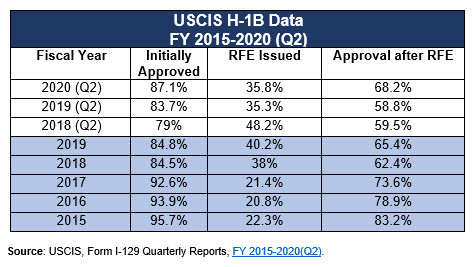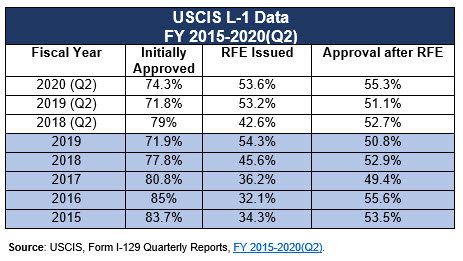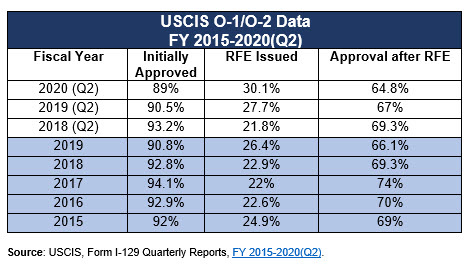Latest USCIS Data Show RFE Rates Remained High for Key Employer-Sponsored Nonimmigrant Categories in Q2 of FY 2020
U.S. Citizenship and Immigration Services (USCIS) data for the second quarter of FY 2020 show continued high rates of requests for evidence (RFEs) in key employer-sponsored nonimmigrant categories, though there was some improvement in H-1B, L-1 and TN outcomes. The overall RFE and denial trends are consistent with the Trump Administration’s directive to tighten employment-based visa eligibility under the Buy American, Hire American Executive Order.
USCIS H-1B Approvals Up Modestly, as RFEs Increased
In the second quarter of FY 2020, the H-1B approval rate was 87.1%, up almost 4% from the same period in FY 2019. Approval rates remain well below FY 2015’s overall H-1B approval rate of 95.7%.
The H-1B RFE rate was 35.8% in the second quarter of FY 2020, up 0.5% from the same period in FY 2019. RFE rates remain well above FY 2015’s rate of 22.3%. The odds of approval after an RFE were 68.2%, up nearly 10% from the same quarter in FY 2019. The rate of approvals after RFE remain well below FY 2015’s rate of 83.2%.h

USCIS L-1 Approvals Up modestly, as RFEs Increased
The approval rate for L-1 petitions at USCIS Service Centers was 74.3%, up just over 2% from the same period in FY 2019, and down almost 10% from FY 2015’s approval rate of 83.7%. L-1 filings were RFE’d at a rate of 53.6%, up 0.4% from the same period in FY 2019, and up almost 20% from FY 2015’s overall RFE rate of 34.3%. The rate of approval after RFE was 55.3% in the second quarter of FY 2020, slightly up from Q1 of FY 2019, but generally on par with the post-RFE approval rate of recent years.
The USCIS statistics do not include outcomes from L-1 applications at U.S. consulates or ports of entry.l

USCIS TN Approvals Up modestly, as RFEs Increased
The approval rate for TN petitions at USCIS was 88.7% in the second quarter of FY 2020, up 0.3% from the same period in FY 2019 and well under FY 2015’s overall USCIS TN approval rate of 95.1%. The rate of RFEs for TN petitions was 25% in the second quarter of this fiscal year, up 0.5% from the same period in FY 2019. The rate of approval after RFE was 58%, up just over 3% from the same period in FY 2019, and nearly 15% lower than the post-RFE approval rate of FY 2015.
The USCIS statistics do not include outcomes from TN applications at ports of entry or U.S. consulates.t

O-1 Approvals Dropped Slightly, as RFEs Increased
The rate of O-1 approvals is down by nearly 5% from its recent high of 94.1% in FY 2017. O-1 petitions were approved at a rate of 89% in the second quarter of this year, down 0.5% from the same period in FY 2019. The RFE rate rose to 30.1%, up just over 2% from the second quarter of FY 2019. Post-RFE approvals declined, to 64.8% from 67% in Q2 of FY 2019.o

What this Means for Employers
USCIS’s second-quarter statistics for FY 2020 show slight improvement in outcomes in the H-1B, L-1 and TN categories; however, RFE rates increased or remained at their already high levels.
Although a presidential proclamation issued late last month temporarily suspends the entry of certain immigrants and does not have an immediate impact on the H-1B, L-1 and other nonimmigrant worker programs, the proclamation directs the departments of Homeland Security and Labor to review the impact of nonimmigrant workers on U.S. workers. The results of that report could lead to future restrictions on nonimmigrant employment categories, with higher denial and RFE rates.
